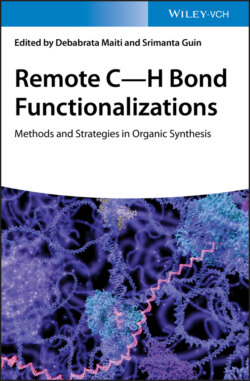Читать книгу Remote C-H Bond Functionalizations - Группа авторов - Страница 16
2.2.3 Amine and N‐Heterocyclic Arene Derivatives 2.2.3.1 Aniline Derivatives
ОглавлениеAmine substituents on arenes are known strong ortho/para directors in electrophilic aromatic substitution reactions such as electrophilic palladation. Thus, to achieve meta‐C–H activation of anilines is extremely challenging [30]. During engineering the meta‐directing template for tetrahydroquinolines, Yu and coworkers found that a fluorine substituent in the auxiliary scaffold would induce a significant change in the conformation of the substrate (vide infra) [31]. Subsequently, a nitrile‐based template bearing a fluorine was discovered (Scheme 2.20) [31], and this template also favored the process of meta‐C–H activation of anilines, successfully overriding the electronic bias toward possible ortho‐palladation assisted by the amide directing group. Notably, the MPAA ligand Ac‐Gly‐OH and HFIP solvent were still the two key elements to enhance the reactivity and site selectivity of the reaction.
Scheme 2.20 meta‐C–H olefination of aniline derivatives.
In 2017, the group Li disclosed a novel template for anilines by incorporating readily available and inexpensive carbon dioxide into the nitrile‐based carbamate template (Scheme 2.21a) [32]. A broad range of aniline derivatives, including tetrahydroquinoline, were efficiently meta‐olefinated with palladium(II) acetate as the catalyst (Scheme 2.21b). Notably, the template could be easily removed under mild basic conditions. The practicality of substrate preparation, functional group tolerance, and easy removal of the template makes it a valuable method for the meta‐C–H functionalization of anilines.
Scheme 2.21 (a) synthesis of substrate from CO2 for meta‐C–H activation of aniline. (b) meta‐C–H olefination of aniline carbamates.
Source: (a) Modified from Yang et al. [32].
In 2019, it was found that tertiary anilines were unreactive toward meta‐C–H activation, possibly due to the unfavorable conformation resulted from the p–π conjugation between the lone‐pair electrons of the nitrogen atom and the phenyl ring [33]. Thus, a template for tertiary anilines through a quaternary ammonium salt assembly was devised (Scheme 2.22). Assisted by this novel linkage of template, highly meta‐selective C–H olefination of tertiary anilines was achieved with a range of substrates. The results indicated that the conformation of the substrate in the meta‐selective C–H activation plays a vital role in the templated‐assisted remote C–H functionalization apart from the distance and geometry of the template while being linked with the substrate.
Scheme 2.22 meta‐C–H olefination of tertiary anilines.
Besides meta‐selective C–H olefination of aniline derivatives, meta‐selective C–H acetoxylation, which proceeds via a different Pd(II)/Pd(IV) redox chemistry catalytic cycle as opposed to meta‐C–H olefination, has also been achieved using different nitrile‐based templates by the groups of Yu (Scheme 2.23a) [31] and Li (Scheme 2.23b) [32], respectively. By using the aforementioned templates for meta‐C–H olefination for anilines, a range of aniline derivatives were meta‐acetoxylated with PhI(OAc)2 was the oxidant. It should be noted, however, the meta‐C–H acetoxylation was generally less efficient than the meta‐C–H olefination.
Scheme 2.23 (a) meta‐C–H acetoxylation of aniline amides. (b) meta‐C–H acetoxylation of aniline carbamates.
Source: (a) Modified from Tang et al. [31]; (b) Modified from Yang et al. [32].
